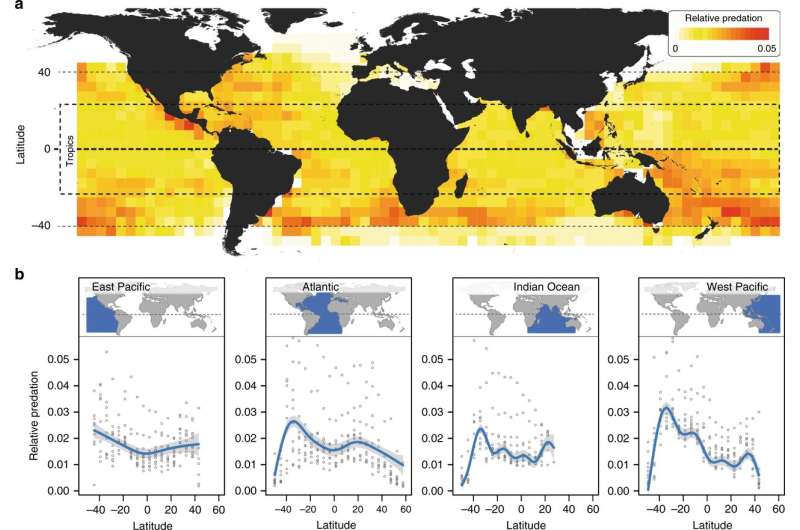April 1, 2020 report
Study shows large ocean predators are more active in temperate regions

An international team of researchers has found that large ocean predators such as tuna, marlin and sharks are more active in temperate regions. In their paper published in the journal Nature Communications, the group describes their analyses of data on attacks by predators on fishing bait in the open ocean over more than a half-century, and what it showed them.
Over the past several decades, Earth scientists have developed a theory called the "biotic interactions hypothesis," which suggests that species interactions (such as predation) are the driving force in creating biodiversity in different parts of the ocean—large predators such as sharks and tuna prey on smaller marine creatures, resulting in biodiversity. The theory has been used to explain why the greatest biodiversity in the world's oceans is near the equator—because there is more predation by large predators. But in recent years, support for the theory has begun to wane as scientists report evidence of exceptions. In this new effort, the researchers have found evidence that will likely overturn the theory completely.
The work involved analyzing data describing attacks on fishing bait by large ocean predators in the open ocean for the years 1960 to 2014. In all, the researchers studied 900 million recorded incidents of large predators trying to steal bait off fishermen longlines.
The researchers found the opposite of what they expected in the data—attacks were more prevalent in temperate regions than they were nearer to the equator. More specifically, they found that most attacks occurred in the mid-latitudes in the 30- to 60-degree range. They also found that the number of attacks was not associated with the degree of biodiversity in a given region.
The researchers wondered if their findings might be tied to industrial fishing, so they compared predator hits over time with fish tallies. They found that predation did drop as more prey were taken from the ocean, but it did not change the ratios of hits between regions—large predators still preferred the mid-latitudes. They suggest their findings will lead to new efforts to explain why there is greater diversity at the equator than in other regions of the ocean.
More information: Marius Roesti et al. Pelagic fish predation is stronger at temperate latitudes than near the equator, Nature Communications (2020). DOI: 10.1038/s41467-020-15335-4
Journal information: Nature Communications
© 2020 Science X Network




















